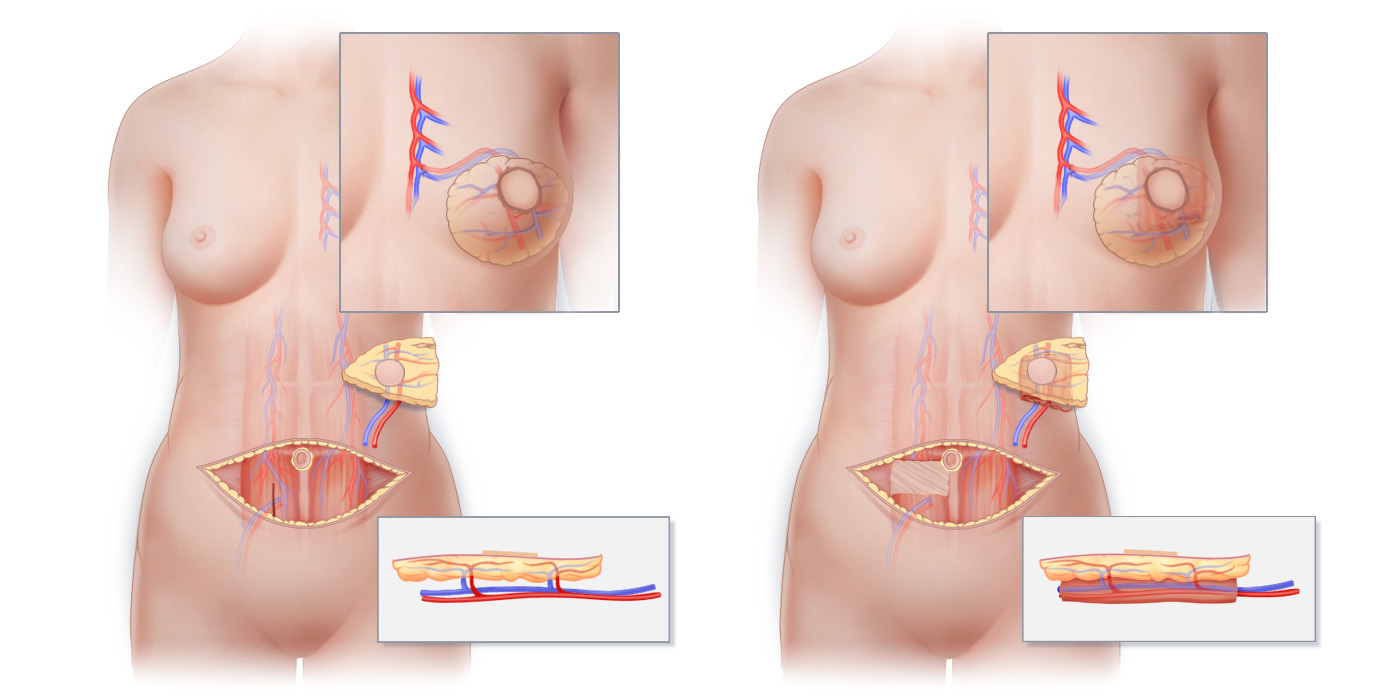Breast Reconstruction with Perforator Flaps
Breast Reconstruction Using Your Own Tissue
Natural-tissue breast reconstruction methods use excess tissue from a woman’s own body to replace breast tissue removed by mastectomy.
- When tissue comes from your own body, it cannot be rejected by your immune system, and there is no need to worry about implant-specific issues such as implant rupture, capsular contracture, or the need for regular MRIs to monitor for “silent” implant leaks.
- Because living tissue used in breast reconstruction actually integrates with the tissue of the body, a breast reconstructed in this manner is typically warm, soft, and supple, and therefore tends to look and feel more natural than a breast reconstructed with a breast implant.
- Natural-tissue breast reconstruction has the potential for the reconstructed breast to develop sensation.
- Breasts reconstructed with a person’s own tissue will change in size with weight gain or loss, in proportion with rest of a person’s body.
One of the most important factors that differentiate flaps from one another is whether or not muscle is used in the breast reconstruction

One of the most important factors differentiating various methods of natural-tissue breast reconstruction from one another is whether or not muscle is surgically removed from a flap’s donor site. Muscle does not grow back, so operations that remove muscle produce life-long changes that include weakness and increased risk for hernias. Perforator flaps such as the deep inferior epigastric perforator flap (DIEP flap) preserve muscle, while musculocutaneous flaps such as the free transverse rectus abdominus myocutaneous flap (free TRAM flap) remove portions of important muscles. (A) Preparation of a DIEP flap takes place without removing any muscle from the abdomen. (B) Preparation of a free TRAM flap requires removal of rectus abdominus muscle from the abdomen. Lower insets show flaps in cross-sectional view.

One of the most important factors differentiating various methods of natural-tissue breast reconstruction from one another is whether or not muscle is surgically removed from a flap’s donor site. Muscle does not grow back, so operations that remove muscle produce life-long changes that include weakness and increased risk for hernias. Perforator flaps such as the deep inferior epigastric perforator flap (DIEP flap) preserve muscle, while musculocutaneous flaps such as the free transverse rectus abdominus myocutaneous flap (free TRAM flap) remove portions of important muscles. (A) Preparation of a DIEP flap takes place without removing any muscle from the abdomen. (B) Preparation of a free TRAM flap requires removal of rectus abdominus muscle from the abdomen. Lower insets show flaps in cross-sectional view.
Perforator Flap Breast Reconstruction
Perforator flaps are the most sophisticated methods of natural-tissue breast reconstruction available. Perforator flaps do not contain muscle. This is an extremely important benefit in comparison to tissue reconstructions such as the TRAM flap and Latissimus flap that disrupt important muscles and weaken the body in the process.
Perforator flaps do not contain muscle.
In addition to giving you excellent cosmetic results without compromising important functional muscles, perforator-flap breast reconstruction offers several unique advantages:
- A more natural look and feel to reconstructed breasts than can typically be obtained with implants
- Less postoperative pain than is typically associated with reconstruction using flaps that include muscle
- Reconstructed breasts that will grow and shrink naturally as one’s weight changes, thereby keeping your reconstructed breast in proportion to your body
- Possible connection of sensory nerves in a perforator flap to nerves at the mastectomy site to help restore sensation to the reconstructed breast
- More rapid return to work and other activities than typically occurs following reconstruction with flaps that include muscle
- A significantly lower rate of unplanned reoperation (only 5%), as compared to the approximately 50% rate reported for implants 7 years after reconstruction
- Ability to reconstruct a breast after failure of an implant or other natural-tissue reconstruction, even after radiation
» Learn more about specific Perforator Flap Procedures
Microsurgical Breast Reconstruction
Advances in the field of microsurgery and the availability of sophisticated microsurgical techniques have revolutionized breast reconstruction surgery in recent years. In particular, when perforator flaps are used for reconstruction, skilled surgeons can shape tissue so that looks and feels as natural as a woman’s own breast. Perforator flap breast reconstruction offers the benefits of autologous breast reconstruction without the disadvantages of procedures that necessitate the sacrifice of muscle.
Our practice specializes in perforator flap breast reconstruction in Greenwich, Connecticut and New York City.

